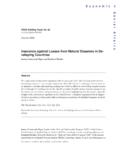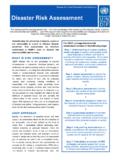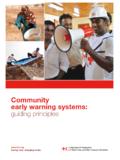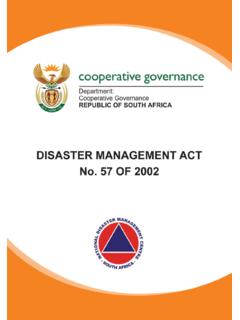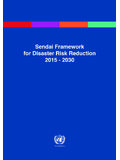Transcription of disast&emerg trng pckge main - World Health …
1 1 DISASTERS&EMERGENCIESDEFINITIONST raining PackageWHO/EHAP anafrican Emergency Training Centre, Addis AbabaUpdated March 2002 by EHA2 WORLDWIDEN umber of People Affected by Disasters0501001502002503003504001990199 119921993199419951996199719981999 YearM illion2000 IFRC World Disaster Report3 Definition :DISASTER :A disaster is an occurrence disruptingthe normal conditions of existence andcausing a level of suffering thatexceeds the capacity of adjustment ofthe affected is the peoplewho matter most, andwithout the peoplewe have no DISASTER -DEVELOPMENTC O N T I N U U M6 RELIEF-DEVELOPMENTCONTINUUMD isaster prevention, mitigation &preparedness safeguard response facilitates recovery s hazards and vulnerabilities havebeen the targets of 30 years ofdevelopment.
2 Their persistence testifies toas many , ever-increasing resources arespent for disaster relief, at the expense only development can reducevulnerabilities, and the hazards arisingfrom the socio-economic DISASTER-DEVELOPMENTCONTINUUMD isasters and crisis ( emergencies )are not aberrant are reflections ofthe ways societiesstructure themselvesand allocate their resources.(R. Kent, 1997)8 DISASTER MORTALITY IN RELATION TO DEVELOPMENT STATUS01020304050607080low incomemiddle incomehigh incomeGross Domestic Product per capitaSource: Centre for Research on the Epidemiology of Disasters, Belgiumdeaths/1,000 population9 Every yearWestern Governments spendUSD 100 billionsubsidizing power stations( Global Warming)USD 300 billionsubsidizing agriculture( Deforestation and Overgrazing)USD 50 billionsubsidizing fisheries( Overfishing)(Worldwatch Institute, 1996)10 EMERGENCYa state in whichnormal proceduresare suspendedandextra-ordinary measures are takenin order to avert a disaster11 Definition.
3 HAZARDA natural or human-made eventthat threatens to adverselyaffects human life, property oractivity to the extent of causinga AND DISASTERS: CLASSIFICATIONSTORMHEAT WAVEFREEZEEARTHQUAKEVOLCANIC ERUPTIONLANDSLIDEDROUGHTFLOODEPIDEMICPES TFIREEXPLOSIONCOLLISIONSHIPWRECKSTRUCTUR AL COLLAPSEENVIRONMENTAL POLLUTIONWARECONOMIC CRISISSUDDENOCCURRENCEMONOCAUSALPROGRESS IVEOCCURRENCEMULTICAUSALSUDDENOCCURRENCE MONOCAUSALPROGRESSIVEOCCURRENCEMULTICAUS ALBY NATURALCAUSESBY HUMANCAUSESDISASTERINSUFFICIENTCAPACITY OFRESPONSE13A disaster occurs when hazards and vulnerability meetTrigger eventEarthquakeHigh winds, stormFloodsLandslideVolcanic eruptionDroughtWar.
4 Civil strifeEconomic crisisTechnological accident vulnerability + Hazard =DISASTERU nderlying causesPovertyLimited access to- power structures- resourcesIdeologiesEconomic systemsAgeSexIllness and disabilitiesDynamic pressuresLack of- local institutions- education- training- appropriate skills- local investments- local markets- services- press freedomMacro-forces- population expansion- urbanization- environment degradationUnsafe conditionsFragile physicalenvironment- dangerous locations- dangerous buildings, local economy- low levels of income- livelihoods at riskPublic actionsVULNERABILITYHAZARD DISASTER14 VULNERABILITYthe predispositionto suffer damagedue to external events15 SUSCEPTIBILITY exposure to dangerRESILIENCE adaptability,capacity to recover16 Poverty, population growth andurbanization forceliving in unsafe areasSite after pressures from population growth and urbanizationSite17 Disaster Management and EmergencyManagementReconstructionRehabil itationResponse/ReliefMitigation/Prevent ionPreparednessEMERGENCY MANAGEMENTPost-disaster.
5 RecoveryPre-disaster: risk reductionDISASTERMANAGEMENTDEVELOPMENT RELIEF18 AIMS OF DISASTERMANAGEMENT reduce (avoid, if possible) thepotential losses from hazards assure prompt and appropriateassistance to victims whennecessary achieve rapid and durablerecovery19 CAPACITY ability, ableness to doCapacity for emergencymanagement is made of: INFORMATION AUTHORITY INSTITUTIONS PARTNERSHIPS PLANS, RESOURCES AND PROCEDURES TO ACTIVATE THEM20 MITIGATION:permanent reduction of the risk ofdisaster Primary Mitigation reducing the PRESENCE of theHazard reducing vulnerability Secondary Mitigation.
6 Reducing the EFFECTS of the Hazard(Preparedness)21 PREPAREDNESSthe measures that ensurethe organized mobilization ofpersonnel,funds,equipment and supplieswithin a safe environmentfor effective relief22 RESPONSEthe set of activities implemented after theimpact of a disaster in order to assess the needs reduce the suffering limit the spread and the consequences of the disaster open the way to rehabilitation23 REHABILITATION:The restoration of basic social :The full resumption of socio-economicactivities plus preventive OF DISASTERMANAGEMENT disaster preparedness planning* vulnerability and risk assessment disaster response* disaster assessment rehabilitation & reconstruction disaster mitigation25 Disaster management: leading activities and related termsDisaster occurrence Disaster ManagementDisaster MitigationDisaster ResponseRisk Search & rescue Security Food Water Shelter & sanitation Clothes & blankets Health carePre-disasterPost-disasterHazard assessment.
7 Mapping, monitoringVulnerability assessment:assessment of vulnerabilityfor all elements exposedto the hazardRisk assessment:calculation of expectedlossesStructural measures:special building codes,dams, floodwalls, :land use planning, laws,insurance, publiceducation, planning:plan of action in caseof disaster, trainingof teamsWarning and Evacuation:development ofindicators& early warning systems,simulation exercisesImmediate :..by definition, resumption ofsocio-economicfunctions, :..monthsto ofbasicsocial :.. weeksto months26 Comparing the natural history of disaster with the disaster-development continuumPRE-PATHOGENIC PERIOD PATHOGENIC PERIODP opulationEnvironmentHazardsIMPACTP olitical awarenessLevel of sufferingdeathsextintiondisintegrationdi sappearance ofthe communityrecovery andresumptionof developmentthe length ofthe latency willbe a functionofPreparednessand ReadinessVULNERABILITY ALERT READINESS R E L I E F REHABILITATION RECONSTRUCTIONPREVENTION PREPAREDNESS R E S P O N S E
8 RECOVERYEMERGENCY MANAGEMENTPREVENTION& MITIGATION RESPONSE & RECOVERYDISASTER MANAGEMENT( Health Promotion and) SECONDARY TERTIARYPRIMARY PREVENTION PREVENTION PREVENTIONH E A L T H C A R EPRE-DISASTER DISASTER POST-DISASTERDISTANT IMMEDIATE LATECY EMERGENCY IMMEDIATE DISTANT











